Case Study Essay Template: Analyzing a Patient's Symptoms and Vital Signs for Diagnosis
VerifiedAdded on 2023/04/24
|11
|2749
|344
AI Summary
In this document we will discuss about Analyzing a Patient's Symptoms and Vital Signs for Diagnosis and below are the summary points of this document:-
Patient Carol Jones, 45 years old, presents with breathlessness, high blood pressure (170/93 mmHg), and irregular pulse rate (160 bpm).
Carol has a busy lifestyle as a consultant engineer, frequently traveling and relying on fast food and alcohol for meals.
The sudden episode of breathlessness and abnormal vital signs indicate potential underlying cardiovascular issues.
Contribute Materials
Your contribution can guide someone’s learning journey. Share your
documents today.
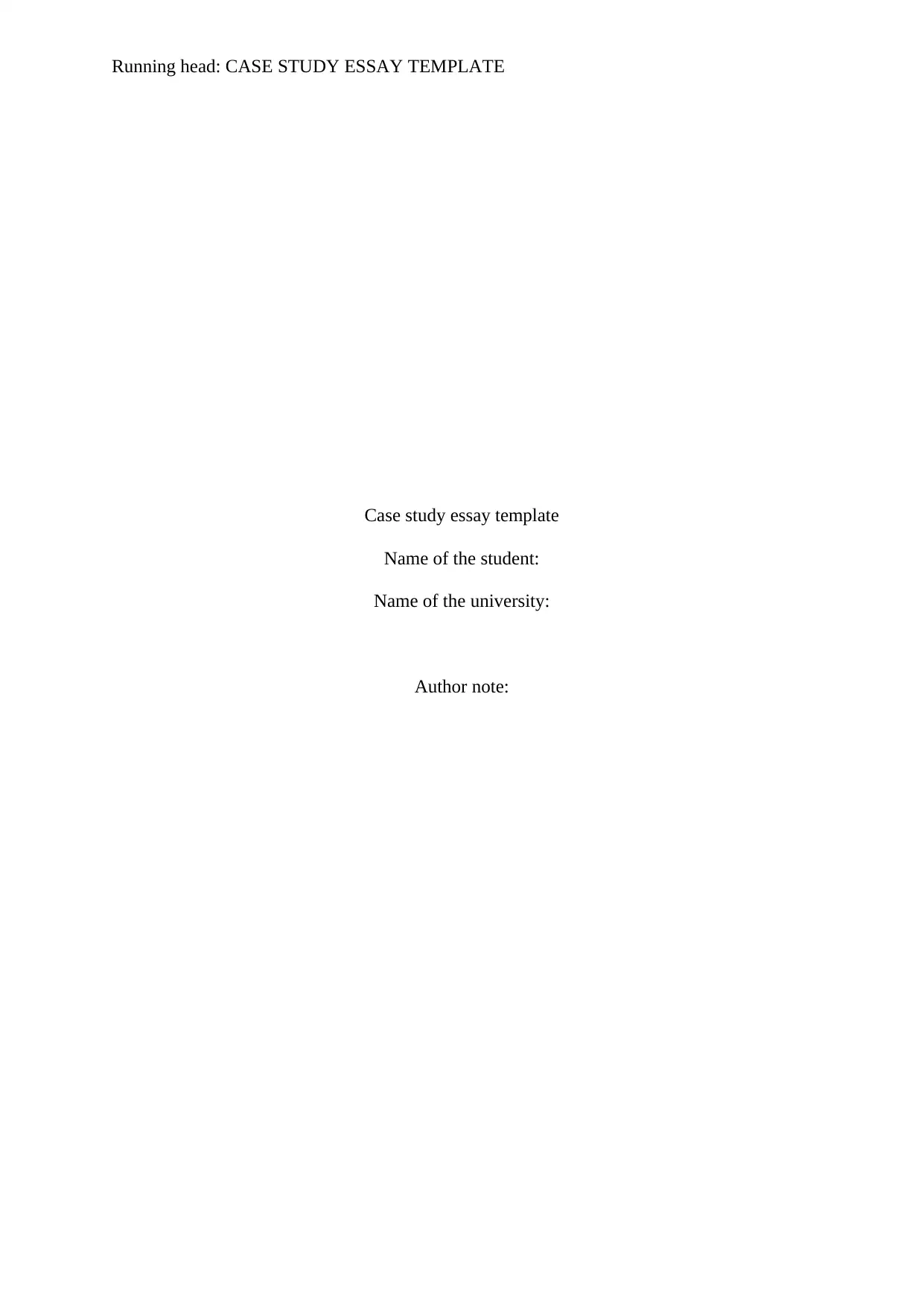
Running head: CASE STUDY ESSAY TEMPLATE
Case study essay template
Name of the student:
Name of the university:
Author note:
Case study essay template
Name of the student:
Name of the university:
Author note:
Secure Best Marks with AI Grader
Need help grading? Try our AI Grader for instant feedback on your assignments.
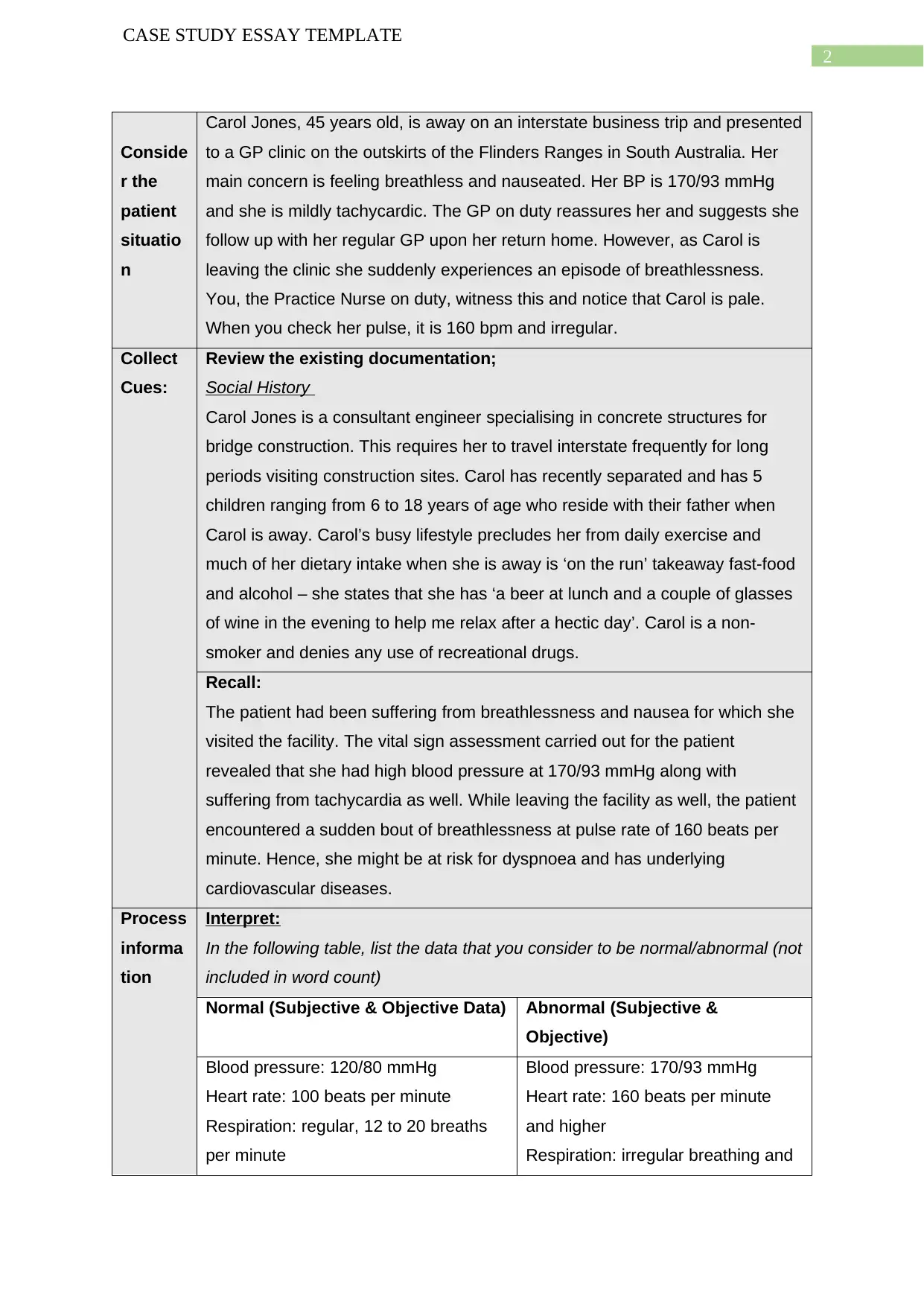
2
CASE STUDY ESSAY TEMPLATE
Conside
r the
patient
situatio
n
Carol Jones, 45 years old, is away on an interstate business trip and presented
to a GP clinic on the outskirts of the Flinders Ranges in South Australia. Her
main concern is feeling breathless and nauseated. Her BP is 170/93 mmHg
and she is mildly tachycardic. The GP on duty reassures her and suggests she
follow up with her regular GP upon her return home. However, as Carol is
leaving the clinic she suddenly experiences an episode of breathlessness.
You, the Practice Nurse on duty, witness this and notice that Carol is pale.
When you check her pulse, it is 160 bpm and irregular.
Collect
Cues:
Review the existing documentation;
Social History
Carol Jones is a consultant engineer specialising in concrete structures for
bridge construction. This requires her to travel interstate frequently for long
periods visiting construction sites. Carol has recently separated and has 5
children ranging from 6 to 18 years of age who reside with their father when
Carol is away. Carol’s busy lifestyle precludes her from daily exercise and
much of her dietary intake when she is away is ‘on the run’ takeaway fast-food
and alcohol – she states that she has ‘a beer at lunch and a couple of glasses
of wine in the evening to help me relax after a hectic day’. Carol is a non-
smoker and denies any use of recreational drugs.
Recall:
The patient had been suffering from breathlessness and nausea for which she
visited the facility. The vital sign assessment carried out for the patient
revealed that she had high blood pressure at 170/93 mmHg along with
suffering from tachycardia as well. While leaving the facility as well, the patient
encountered a sudden bout of breathlessness at pulse rate of 160 beats per
minute. Hence, she might be at risk for dyspnoea and has underlying
cardiovascular diseases.
Process
informa
tion
Interpret:
In the following table, list the data that you consider to be normal/abnormal (not
included in word count)
Normal (Subjective & Objective Data) Abnormal (Subjective &
Objective)
Blood pressure: 120/80 mmHg
Heart rate: 100 beats per minute
Respiration: regular, 12 to 20 breaths
per minute
Blood pressure: 170/93 mmHg
Heart rate: 160 beats per minute
and higher
Respiration: irregular breathing and
CASE STUDY ESSAY TEMPLATE
Conside
r the
patient
situatio
n
Carol Jones, 45 years old, is away on an interstate business trip and presented
to a GP clinic on the outskirts of the Flinders Ranges in South Australia. Her
main concern is feeling breathless and nauseated. Her BP is 170/93 mmHg
and she is mildly tachycardic. The GP on duty reassures her and suggests she
follow up with her regular GP upon her return home. However, as Carol is
leaving the clinic she suddenly experiences an episode of breathlessness.
You, the Practice Nurse on duty, witness this and notice that Carol is pale.
When you check her pulse, it is 160 bpm and irregular.
Collect
Cues:
Review the existing documentation;
Social History
Carol Jones is a consultant engineer specialising in concrete structures for
bridge construction. This requires her to travel interstate frequently for long
periods visiting construction sites. Carol has recently separated and has 5
children ranging from 6 to 18 years of age who reside with their father when
Carol is away. Carol’s busy lifestyle precludes her from daily exercise and
much of her dietary intake when she is away is ‘on the run’ takeaway fast-food
and alcohol – she states that she has ‘a beer at lunch and a couple of glasses
of wine in the evening to help me relax after a hectic day’. Carol is a non-
smoker and denies any use of recreational drugs.
Recall:
The patient had been suffering from breathlessness and nausea for which she
visited the facility. The vital sign assessment carried out for the patient
revealed that she had high blood pressure at 170/93 mmHg along with
suffering from tachycardia as well. While leaving the facility as well, the patient
encountered a sudden bout of breathlessness at pulse rate of 160 beats per
minute. Hence, she might be at risk for dyspnoea and has underlying
cardiovascular diseases.
Process
informa
tion
Interpret:
In the following table, list the data that you consider to be normal/abnormal (not
included in word count)
Normal (Subjective & Objective Data) Abnormal (Subjective &
Objective)
Blood pressure: 120/80 mmHg
Heart rate: 100 beats per minute
Respiration: regular, 12 to 20 breaths
per minute
Blood pressure: 170/93 mmHg
Heart rate: 160 beats per minute
and higher
Respiration: irregular breathing and

3
CASE STUDY ESSAY TEMPLATE
feeling out of breath.
Relate & Infer: (250 words)
Relate: cluster cues by identifying relationships between them.
• ...............................Infer: make deductions as to why a cue, or a cluster of cues may be
considered abnormal in this context. Justify by referring to appropriate
anatomy, physiology and pathophysiology.
Refer to Levett-Jones (2018) Clinical Reasoning p7.
•......................Based on your interpretation of all the information/cues presented, form
and justify an overall opinion on what may be happening
This is one of the most important and impactful section of the clinical reasoning
cycle, and this phase allows the different individuals to cluster the collected
patient care cues and identify the interconnection between the cues so that the
exact care need of the patient can be identified. In this section the anomaly in
the care cues are identified with justification on why the cues are considered
anomalous with respect to proper or appropriate anatomy, physiology and
pathophysiology.
In this case, the patient had extremely high blood pressure and extremely high
heart rate. The hypertension and high heart rate is a very common health
adversity for the median age group of 45 and onwards. As discussed by
Sokolska et al. (2018), the risk of cardiovascular diseases post the age of 40-
45 is exceptionally high. Similarly, shortness of breath or dyspnoea is
characterized by sudden and frequent bouts of breathlessness; and the onset
of dyspnoea is also abundantly observed in patients with underlying
cardiovascular diseases. While leaving the facility, she again encountered a
bout of breathlessness, which was associated with heart rate being higher than
160 bpm. Relating it with her past medical history of tachycardia, she is
exhibiting possible risk of atrial fibrillation requiring immediate medical attention
(Laviolette and Laveneziana 2014).
Predict: (100 words)
Explain what may happen to your patient if no action is taken
In this case, she requires immediate external oxygen therapy and medication
to reduce her heart rate and blood pressure. From the analysis above, it can
be stated that she had been suffering from possible arterial blockage or similar
cardiovascular disorders, apparent from her high blood pressure and
tachycardia. In case she is not provided external oxygen therapy, she might
CASE STUDY ESSAY TEMPLATE
feeling out of breath.
Relate & Infer: (250 words)
Relate: cluster cues by identifying relationships between them.
• ...............................Infer: make deductions as to why a cue, or a cluster of cues may be
considered abnormal in this context. Justify by referring to appropriate
anatomy, physiology and pathophysiology.
Refer to Levett-Jones (2018) Clinical Reasoning p7.
•......................Based on your interpretation of all the information/cues presented, form
and justify an overall opinion on what may be happening
This is one of the most important and impactful section of the clinical reasoning
cycle, and this phase allows the different individuals to cluster the collected
patient care cues and identify the interconnection between the cues so that the
exact care need of the patient can be identified. In this section the anomaly in
the care cues are identified with justification on why the cues are considered
anomalous with respect to proper or appropriate anatomy, physiology and
pathophysiology.
In this case, the patient had extremely high blood pressure and extremely high
heart rate. The hypertension and high heart rate is a very common health
adversity for the median age group of 45 and onwards. As discussed by
Sokolska et al. (2018), the risk of cardiovascular diseases post the age of 40-
45 is exceptionally high. Similarly, shortness of breath or dyspnoea is
characterized by sudden and frequent bouts of breathlessness; and the onset
of dyspnoea is also abundantly observed in patients with underlying
cardiovascular diseases. While leaving the facility, she again encountered a
bout of breathlessness, which was associated with heart rate being higher than
160 bpm. Relating it with her past medical history of tachycardia, she is
exhibiting possible risk of atrial fibrillation requiring immediate medical attention
(Laviolette and Laveneziana 2014).
Predict: (100 words)
Explain what may happen to your patient if no action is taken
In this case, she requires immediate external oxygen therapy and medication
to reduce her heart rate and blood pressure. From the analysis above, it can
be stated that she had been suffering from possible arterial blockage or similar
cardiovascular disorders, apparent from her high blood pressure and
tachycardia. In case she is not provided external oxygen therapy, she might
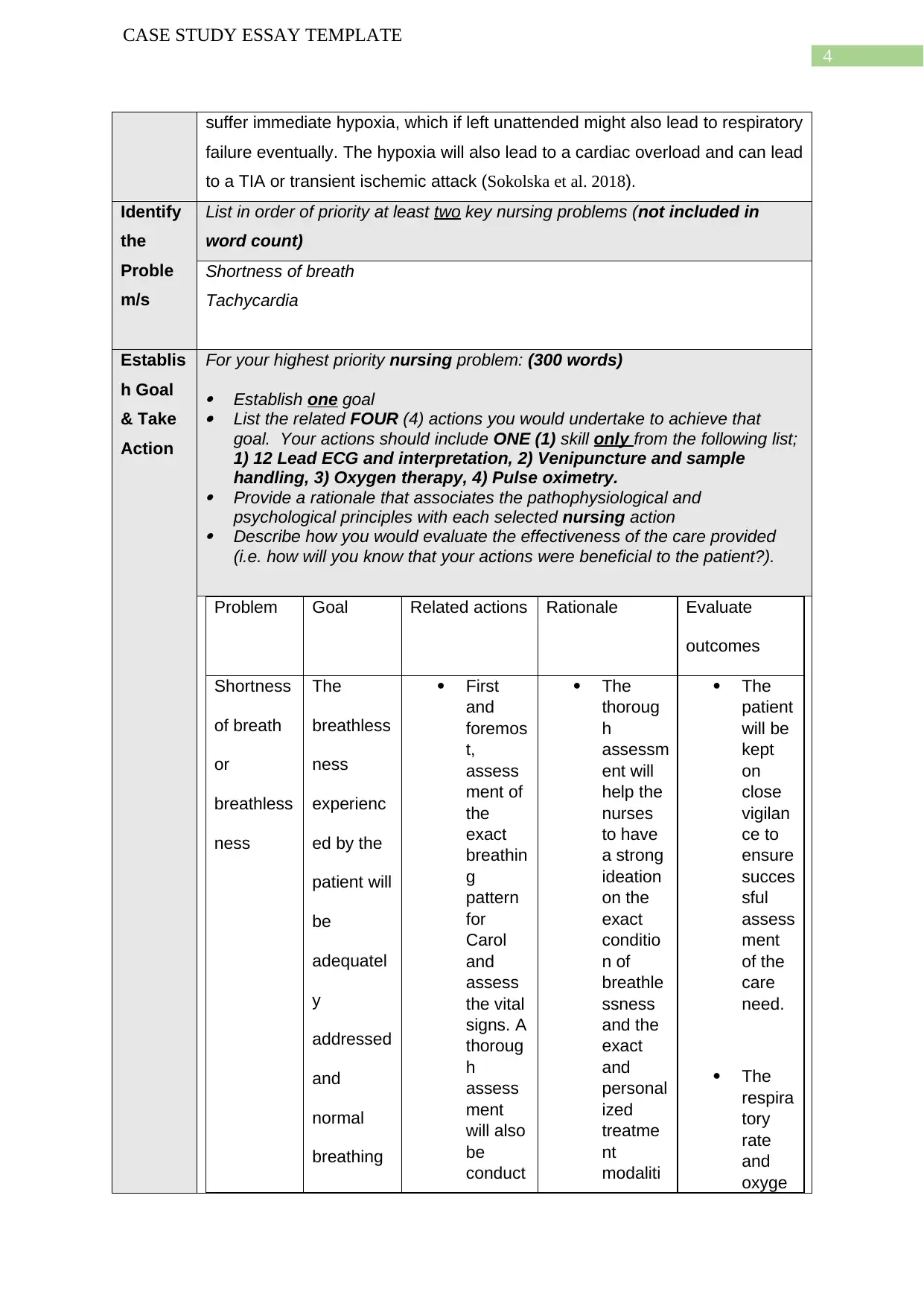
4
CASE STUDY ESSAY TEMPLATE
suffer immediate hypoxia, which if left unattended might also lead to respiratory
failure eventually. The hypoxia will also lead to a cardiac overload and can lead
to a TIA or transient ischemic attack (Sokolska et al. 2018).
Identify
the
Proble
m/s
List in order of priority at least two key nursing problems (not included in
word count)
Shortness of breath
Tachycardia
Establis
h Goal
& Take
Action
For your highest priority nursing problem: (300 words)
Establish one goal
List the related FOUR (4) actions you would undertake to achieve that
goal. Your actions should include ONE (1) skill only from the following list;
1) 12 Lead ECG and interpretation, 2) Venipuncture and sample
handling, 3) Oxygen therapy, 4) Pulse oximetry.
Provide a rationale that associates the pathophysiological and
psychological principles with each selected nursing action
Describe how you would evaluate the effectiveness of the care provided
(i.e. how will you know that your actions were beneficial to the patient?).
Problem Goal Related actions Rationale Evaluate
outcomes
Shortness
of breath
or
breathless
ness
The
breathless
ness
experienc
ed by the
patient will
be
adequatel
y
addressed
and
normal
breathing
First
and
foremos
t,
assess
ment of
the
exact
breathin
g
pattern
for
Carol
and
assess
the vital
signs. A
thoroug
h
assess
ment
will also
be
conduct
The
thoroug
h
assessm
ent will
help the
nurses
to have
a strong
ideation
on the
exact
conditio
n of
breathle
ssness
and the
exact
and
personal
ized
treatme
nt
modaliti
The
patient
will be
kept
on
close
vigilan
ce to
ensure
succes
sful
assess
ment
of the
care
need.
The
respira
tory
rate
and
oxyge
CASE STUDY ESSAY TEMPLATE
suffer immediate hypoxia, which if left unattended might also lead to respiratory
failure eventually. The hypoxia will also lead to a cardiac overload and can lead
to a TIA or transient ischemic attack (Sokolska et al. 2018).
Identify
the
Proble
m/s
List in order of priority at least two key nursing problems (not included in
word count)
Shortness of breath
Tachycardia
Establis
h Goal
& Take
Action
For your highest priority nursing problem: (300 words)
Establish one goal
List the related FOUR (4) actions you would undertake to achieve that
goal. Your actions should include ONE (1) skill only from the following list;
1) 12 Lead ECG and interpretation, 2) Venipuncture and sample
handling, 3) Oxygen therapy, 4) Pulse oximetry.
Provide a rationale that associates the pathophysiological and
psychological principles with each selected nursing action
Describe how you would evaluate the effectiveness of the care provided
(i.e. how will you know that your actions were beneficial to the patient?).
Problem Goal Related actions Rationale Evaluate
outcomes
Shortness
of breath
or
breathless
ness
The
breathless
ness
experienc
ed by the
patient will
be
adequatel
y
addressed
and
normal
breathing
First
and
foremos
t,
assess
ment of
the
exact
breathin
g
pattern
for
Carol
and
assess
the vital
signs. A
thoroug
h
assess
ment
will also
be
conduct
The
thoroug
h
assessm
ent will
help the
nurses
to have
a strong
ideation
on the
exact
conditio
n of
breathle
ssness
and the
exact
and
personal
ized
treatme
nt
modaliti
The
patient
will be
kept
on
close
vigilan
ce to
ensure
succes
sful
assess
ment
of the
care
need.
The
respira
tory
rate
and
oxyge
Secure Best Marks with AI Grader
Need help grading? Try our AI Grader for instant feedback on your assignments.
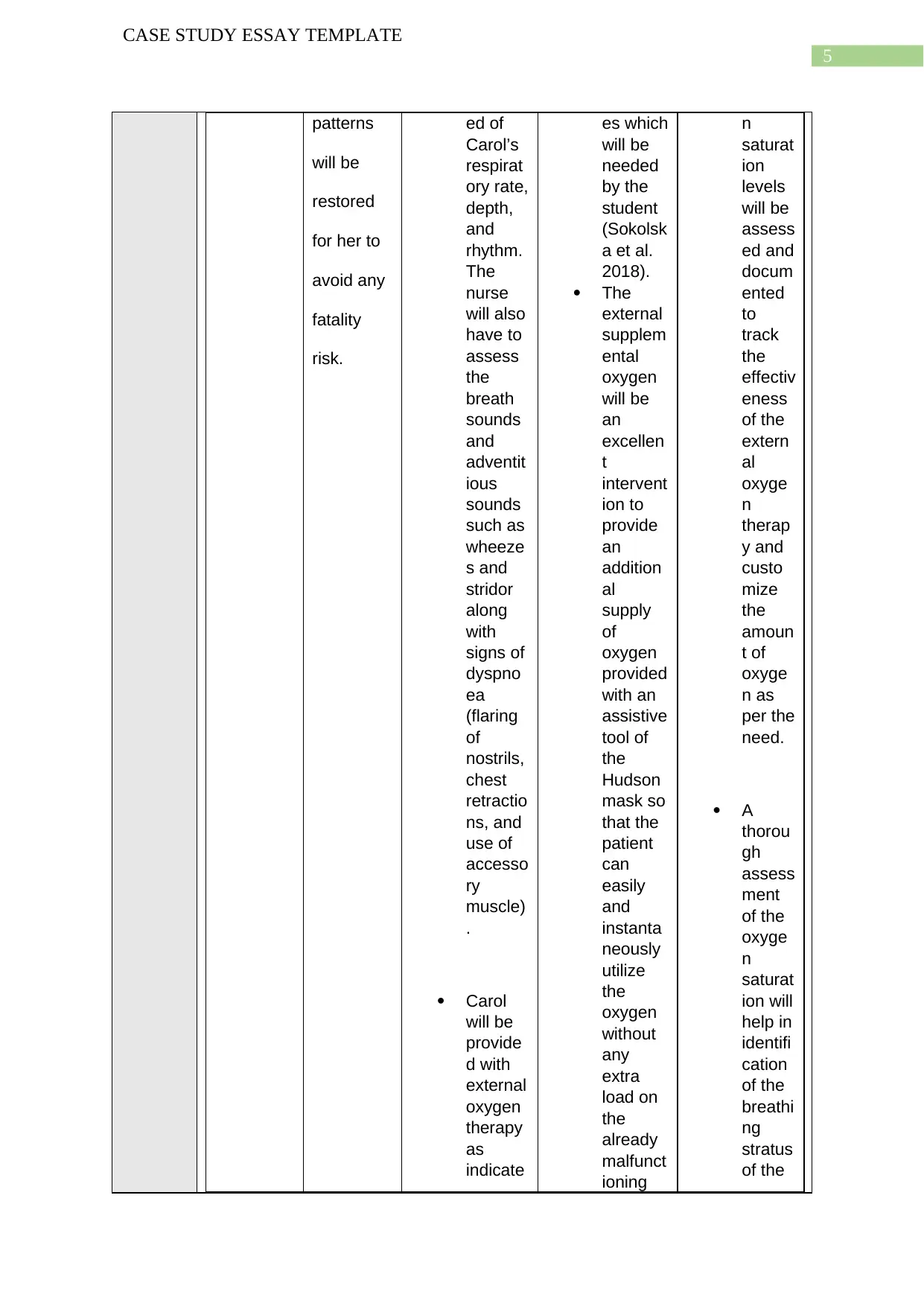
5
CASE STUDY ESSAY TEMPLATE
patterns
will be
restored
for her to
avoid any
fatality
risk.
ed of
Carol’s
respirat
ory rate,
depth,
and
rhythm.
The
nurse
will also
have to
assess
the
breath
sounds
and
adventit
ious
sounds
such as
wheeze
s and
stridor
along
with
signs of
dyspno
ea
(flaring
of
nostrils,
chest
retractio
ns, and
use of
accesso
ry
muscle)
.
Carol
will be
provide
d with
external
oxygen
therapy
as
indicate
es which
will be
needed
by the
student
(Sokolsk
a et al.
2018).
The
external
supplem
ental
oxygen
will be
an
excellen
t
intervent
ion to
provide
an
addition
al
supply
of
oxygen
provided
with an
assistive
tool of
the
Hudson
mask so
that the
patient
can
easily
and
instanta
neously
utilize
the
oxygen
without
any
extra
load on
the
already
malfunct
ioning
n
saturat
ion
levels
will be
assess
ed and
docum
ented
to
track
the
effectiv
eness
of the
extern
al
oxyge
n
therap
y and
custo
mize
the
amoun
t of
oxyge
n as
per the
need.
A
thorou
gh
assess
ment
of the
oxyge
n
saturat
ion will
help in
identifi
cation
of the
breathi
ng
stratus
of the
CASE STUDY ESSAY TEMPLATE
patterns
will be
restored
for her to
avoid any
fatality
risk.
ed of
Carol’s
respirat
ory rate,
depth,
and
rhythm.
The
nurse
will also
have to
assess
the
breath
sounds
and
adventit
ious
sounds
such as
wheeze
s and
stridor
along
with
signs of
dyspno
ea
(flaring
of
nostrils,
chest
retractio
ns, and
use of
accesso
ry
muscle)
.
Carol
will be
provide
d with
external
oxygen
therapy
as
indicate
es which
will be
needed
by the
student
(Sokolsk
a et al.
2018).
The
external
supplem
ental
oxygen
will be
an
excellen
t
intervent
ion to
provide
an
addition
al
supply
of
oxygen
provided
with an
assistive
tool of
the
Hudson
mask so
that the
patient
can
easily
and
instanta
neously
utilize
the
oxygen
without
any
extra
load on
the
already
malfunct
ioning
n
saturat
ion
levels
will be
assess
ed and
docum
ented
to
track
the
effectiv
eness
of the
extern
al
oxyge
n
therap
y and
custo
mize
the
amoun
t of
oxyge
n as
per the
need.
A
thorou
gh
assess
ment
of the
oxyge
n
saturat
ion will
help in
identifi
cation
of the
breathi
ng
stratus
of the
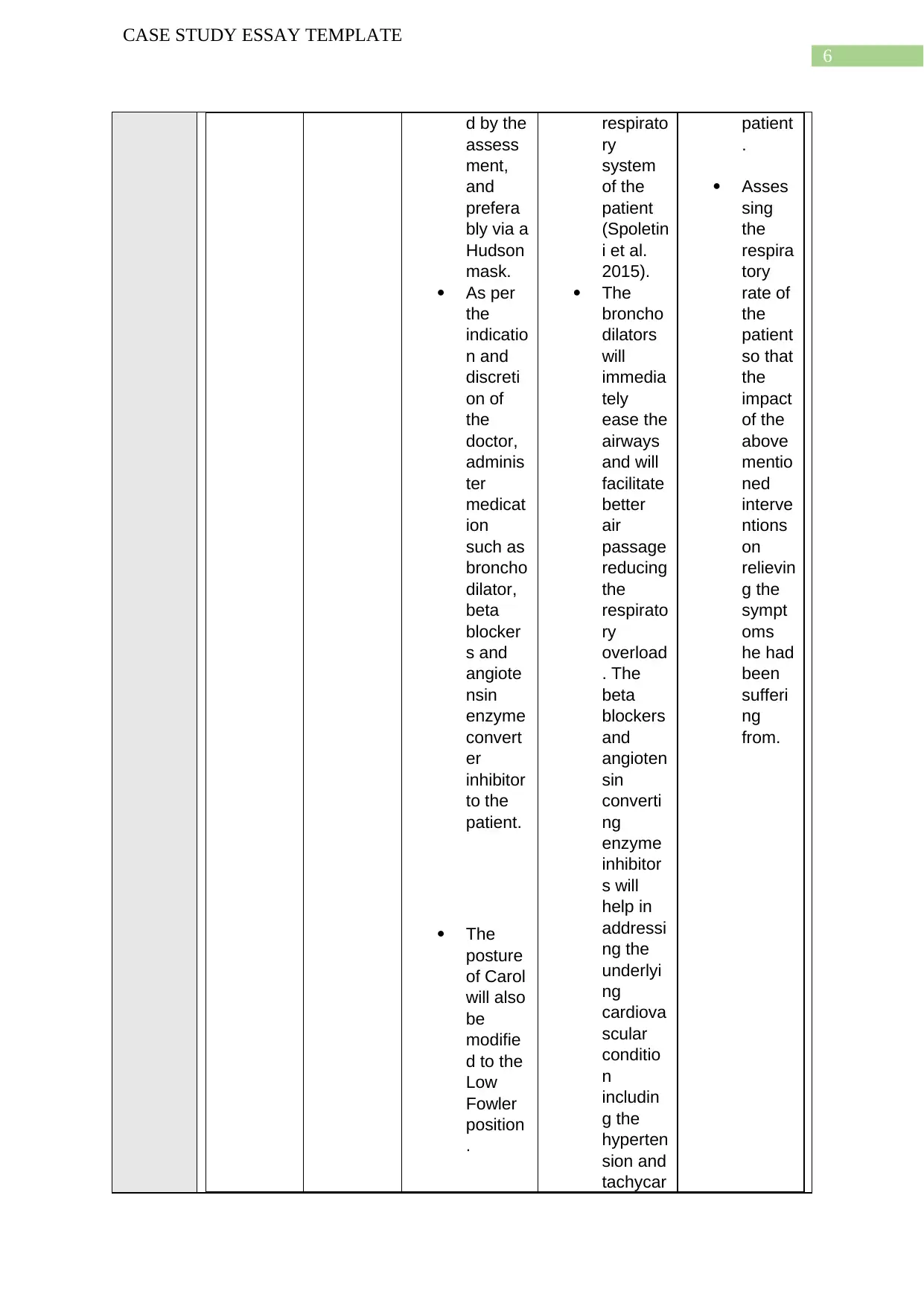
6
CASE STUDY ESSAY TEMPLATE
d by the
assess
ment,
and
prefera
bly via a
Hudson
mask.
As per
the
indicatio
n and
discreti
on of
the
doctor,
adminis
ter
medicat
ion
such as
broncho
dilator,
beta
blocker
s and
angiote
nsin
enzyme
convert
er
inhibitor
to the
patient.
The
posture
of Carol
will also
be
modifie
d to the
Low
Fowler
position
.
respirato
ry
system
of the
patient
(Spoletin
i et al.
2015).
The
broncho
dilators
will
immedia
tely
ease the
airways
and will
facilitate
better
air
passage
reducing
the
respirato
ry
overload
. The
beta
blockers
and
angioten
sin
converti
ng
enzyme
inhibitor
s will
help in
addressi
ng the
underlyi
ng
cardiova
scular
conditio
n
includin
g the
hyperten
sion and
tachycar
patient
.
Asses
sing
the
respira
tory
rate of
the
patient
so that
the
impact
of the
above
mentio
ned
interve
ntions
on
relievin
g the
sympt
oms
he had
been
sufferi
ng
from.
CASE STUDY ESSAY TEMPLATE
d by the
assess
ment,
and
prefera
bly via a
Hudson
mask.
As per
the
indicatio
n and
discreti
on of
the
doctor,
adminis
ter
medicat
ion
such as
broncho
dilator,
beta
blocker
s and
angiote
nsin
enzyme
convert
er
inhibitor
to the
patient.
The
posture
of Carol
will also
be
modifie
d to the
Low
Fowler
position
.
respirato
ry
system
of the
patient
(Spoletin
i et al.
2015).
The
broncho
dilators
will
immedia
tely
ease the
airways
and will
facilitate
better
air
passage
reducing
the
respirato
ry
overload
. The
beta
blockers
and
angioten
sin
converti
ng
enzyme
inhibitor
s will
help in
addressi
ng the
underlyi
ng
cardiova
scular
conditio
n
includin
g the
hyperten
sion and
tachycar
patient
.
Asses
sing
the
respira
tory
rate of
the
patient
so that
the
impact
of the
above
mentio
ned
interve
ntions
on
relievin
g the
sympt
oms
he had
been
sufferi
ng
from.
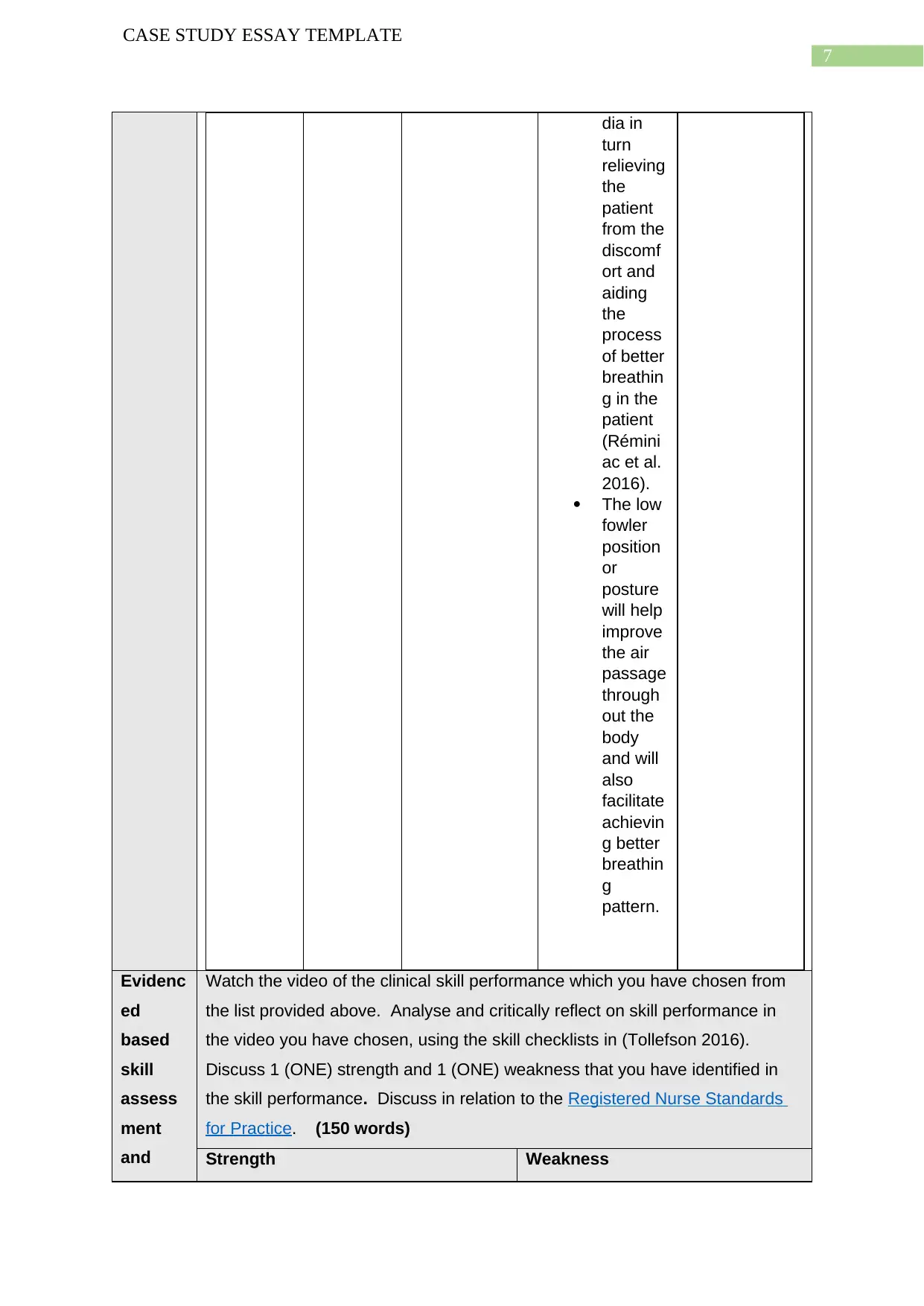
7
CASE STUDY ESSAY TEMPLATE
dia in
turn
relieving
the
patient
from the
discomf
ort and
aiding
the
process
of better
breathin
g in the
patient
(Rémini
ac et al.
2016).
The low
fowler
position
or
posture
will help
improve
the air
passage
through
out the
body
and will
also
facilitate
achievin
g better
breathin
g
pattern.
Evidenc
ed
based
skill
assess
ment
and
Watch the video of the clinical skill performance which you have chosen from
the list provided above. Analyse and critically reflect on skill performance in
the video you have chosen, using the skill checklists in (Tollefson 2016).
Discuss 1 (ONE) strength and 1 (ONE) weakness that you have identified in
the skill performance. Discuss in relation to the Registered Nurse Standards
for Practice. (150 words)
Strength Weakness
CASE STUDY ESSAY TEMPLATE
dia in
turn
relieving
the
patient
from the
discomf
ort and
aiding
the
process
of better
breathin
g in the
patient
(Rémini
ac et al.
2016).
The low
fowler
position
or
posture
will help
improve
the air
passage
through
out the
body
and will
also
facilitate
achievin
g better
breathin
g
pattern.
Evidenc
ed
based
skill
assess
ment
and
Watch the video of the clinical skill performance which you have chosen from
the list provided above. Analyse and critically reflect on skill performance in
the video you have chosen, using the skill checklists in (Tollefson 2016).
Discuss 1 (ONE) strength and 1 (ONE) weakness that you have identified in
the skill performance. Discuss in relation to the Registered Nurse Standards
for Practice. (150 words)
Strength Weakness
Paraphrase This Document
Need a fresh take? Get an instant paraphrase of this document with our AI Paraphraser
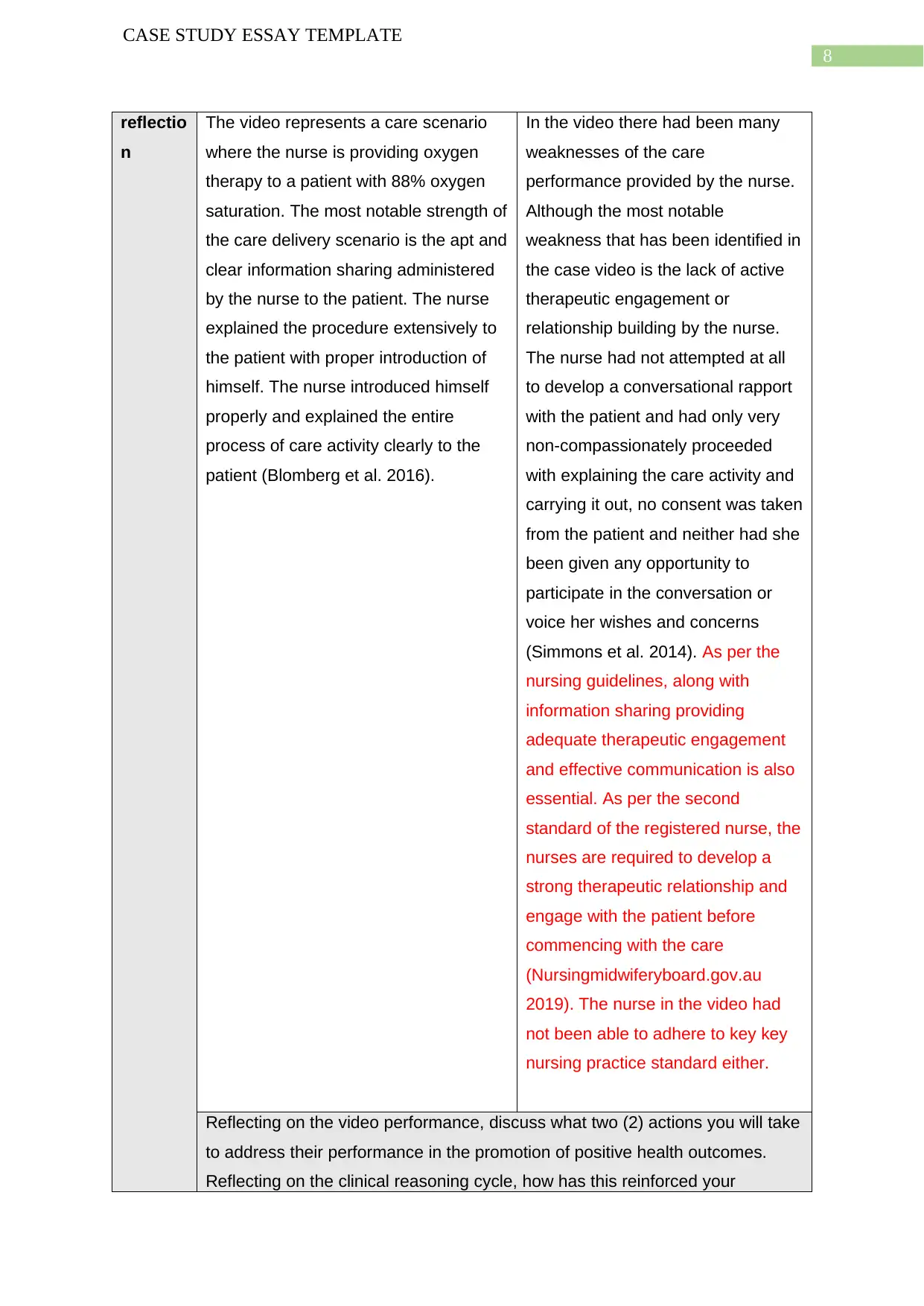
8
CASE STUDY ESSAY TEMPLATE
reflectio
n
The video represents a care scenario
where the nurse is providing oxygen
therapy to a patient with 88% oxygen
saturation. The most notable strength of
the care delivery scenario is the apt and
clear information sharing administered
by the nurse to the patient. The nurse
explained the procedure extensively to
the patient with proper introduction of
himself. The nurse introduced himself
properly and explained the entire
process of care activity clearly to the
patient (Blomberg et al. 2016).
In the video there had been many
weaknesses of the care
performance provided by the nurse.
Although the most notable
weakness that has been identified in
the case video is the lack of active
therapeutic engagement or
relationship building by the nurse.
The nurse had not attempted at all
to develop a conversational rapport
with the patient and had only very
non-compassionately proceeded
with explaining the care activity and
carrying it out, no consent was taken
from the patient and neither had she
been given any opportunity to
participate in the conversation or
voice her wishes and concerns
(Simmons et al. 2014). As per the
nursing guidelines, along with
information sharing providing
adequate therapeutic engagement
and effective communication is also
essential. As per the second
standard of the registered nurse, the
nurses are required to develop a
strong therapeutic relationship and
engage with the patient before
commencing with the care
(Nursingmidwiferyboard.gov.au
2019). The nurse in the video had
not been able to adhere to key key
nursing practice standard either.
Reflecting on the video performance, discuss what two (2) actions you will take
to address their performance in the promotion of positive health outcomes.
Reflecting on the clinical reasoning cycle, how has this reinforced your
CASE STUDY ESSAY TEMPLATE
reflectio
n
The video represents a care scenario
where the nurse is providing oxygen
therapy to a patient with 88% oxygen
saturation. The most notable strength of
the care delivery scenario is the apt and
clear information sharing administered
by the nurse to the patient. The nurse
explained the procedure extensively to
the patient with proper introduction of
himself. The nurse introduced himself
properly and explained the entire
process of care activity clearly to the
patient (Blomberg et al. 2016).
In the video there had been many
weaknesses of the care
performance provided by the nurse.
Although the most notable
weakness that has been identified in
the case video is the lack of active
therapeutic engagement or
relationship building by the nurse.
The nurse had not attempted at all
to develop a conversational rapport
with the patient and had only very
non-compassionately proceeded
with explaining the care activity and
carrying it out, no consent was taken
from the patient and neither had she
been given any opportunity to
participate in the conversation or
voice her wishes and concerns
(Simmons et al. 2014). As per the
nursing guidelines, along with
information sharing providing
adequate therapeutic engagement
and effective communication is also
essential. As per the second
standard of the registered nurse, the
nurses are required to develop a
strong therapeutic relationship and
engage with the patient before
commencing with the care
(Nursingmidwiferyboard.gov.au
2019). The nurse in the video had
not been able to adhere to key key
nursing practice standard either.
Reflecting on the video performance, discuss what two (2) actions you will take
to address their performance in the promotion of positive health outcomes.
Reflecting on the clinical reasoning cycle, how has this reinforced your
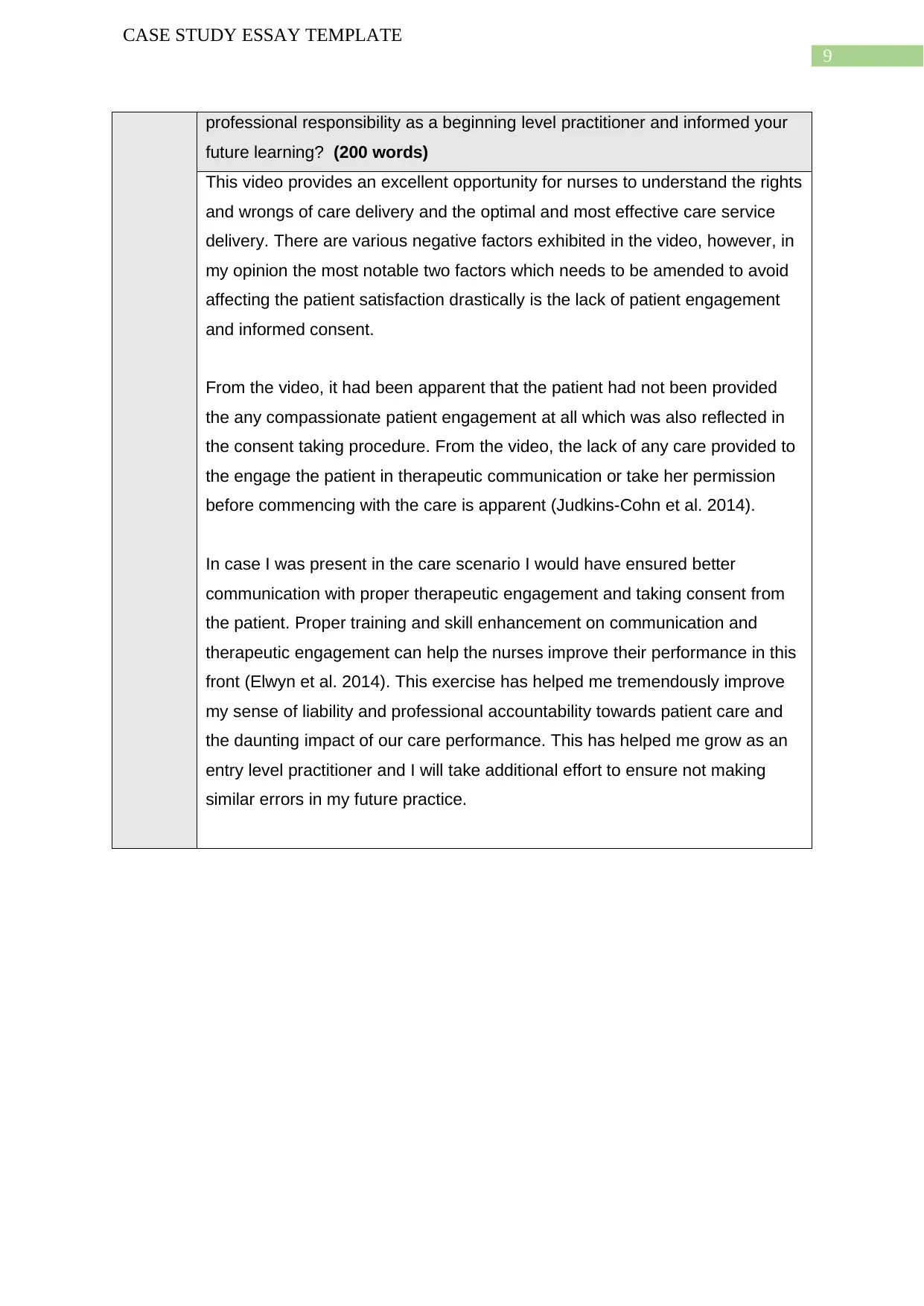
9
CASE STUDY ESSAY TEMPLATE
professional responsibility as a beginning level practitioner and informed your
future learning? (200 words)
This video provides an excellent opportunity for nurses to understand the rights
and wrongs of care delivery and the optimal and most effective care service
delivery. There are various negative factors exhibited in the video, however, in
my opinion the most notable two factors which needs to be amended to avoid
affecting the patient satisfaction drastically is the lack of patient engagement
and informed consent.
From the video, it had been apparent that the patient had not been provided
the any compassionate patient engagement at all which was also reflected in
the consent taking procedure. From the video, the lack of any care provided to
the engage the patient in therapeutic communication or take her permission
before commencing with the care is apparent (Judkins-Cohn et al. 2014).
In case I was present in the care scenario I would have ensured better
communication with proper therapeutic engagement and taking consent from
the patient. Proper training and skill enhancement on communication and
therapeutic engagement can help the nurses improve their performance in this
front (Elwyn et al. 2014). This exercise has helped me tremendously improve
my sense of liability and professional accountability towards patient care and
the daunting impact of our care performance. This has helped me grow as an
entry level practitioner and I will take additional effort to ensure not making
similar errors in my future practice.
CASE STUDY ESSAY TEMPLATE
professional responsibility as a beginning level practitioner and informed your
future learning? (200 words)
This video provides an excellent opportunity for nurses to understand the rights
and wrongs of care delivery and the optimal and most effective care service
delivery. There are various negative factors exhibited in the video, however, in
my opinion the most notable two factors which needs to be amended to avoid
affecting the patient satisfaction drastically is the lack of patient engagement
and informed consent.
From the video, it had been apparent that the patient had not been provided
the any compassionate patient engagement at all which was also reflected in
the consent taking procedure. From the video, the lack of any care provided to
the engage the patient in therapeutic communication or take her permission
before commencing with the care is apparent (Judkins-Cohn et al. 2014).
In case I was present in the care scenario I would have ensured better
communication with proper therapeutic engagement and taking consent from
the patient. Proper training and skill enhancement on communication and
therapeutic engagement can help the nurses improve their performance in this
front (Elwyn et al. 2014). This exercise has helped me tremendously improve
my sense of liability and professional accountability towards patient care and
the daunting impact of our care performance. This has helped me grow as an
entry level practitioner and I will take additional effort to ensure not making
similar errors in my future practice.

10
CASE STUDY ESSAY TEMPLATE
References:
Blomberg, K., Griffiths, P., Wengström, Y., May, C. and Bridges, J., 2016. Interventions for
compassionate nursing care: A systematic review. International Journal of Nursing
Studies, 62, pp.137-155.
Elwyn, G., Lloyd, A., May, C., van der Weijden, T., Stiggelbout, A., Edwards, A., Frosch,
D.L., Rapley, T., Barr, P., Walsh, T. and Grande, S.W., 2014. Collaborative deliberation: a
model for patient care. Patient Education and Counseling, 97(2), pp.158-164.
Judkins-Cohn, T.M., Kielwasser-Withrow, K., Owen, M. and Ward, J., 2014. Ethical
principles of informed consent: Exploring nurses’ dual role of care provider and
researcher. The Journal of Continuing Education in Nursing.
Laviolette, L. and Laveneziana, P., 2014. Dyspnoea: a multidimensional and
multidisciplinary approach. European Respiratory Journal, 43(6), pp.1750-1762.
Nursingmidwiferyboard.gov.au. 2019. Nursing and Midwifery Board of Australia -
Registered nurse standards for practice. [Online] Available at:
https://www.nursingmidwiferyboard.gov.au/codes-guidelines-statements/professional-
standards/registered-nurse-standards-for-practice.aspx [Accessed 23 Jan. 2019].
Réminiac, F., Vecellio, L., Heuzé-Vourc'h, N., Petitcollin, A., Respaud, R., Cabrera, M.,
Pennec, D.L., Diot, P. and Ehrmann, S., 2016. Aerosol therapy in adults receiving high flow
nasal cannula oxygen therapy. Journal of aerosol medicine and pulmonary drug
delivery, 29(2), pp.134-141.
Simmons, L.A., Wolever, R.Q., Bechard, E.M. and Snyderman, R., 2014. Patient engagement
as a risk factor in personalized health care: a systematic review of the literature on chronic
disease. Genome medicine, 6(2), p.16.
Sokolska, J.M., Sokolski, M., Zymliński, R., Biegus, J., Siwołowski, P., Nawrocka‐Millward,
S., Jankowska, E.A., Todd, J., Banasiak, W. and Ponikowski, P., 2018. Patterns of dyspnoea
CASE STUDY ESSAY TEMPLATE
References:
Blomberg, K., Griffiths, P., Wengström, Y., May, C. and Bridges, J., 2016. Interventions for
compassionate nursing care: A systematic review. International Journal of Nursing
Studies, 62, pp.137-155.
Elwyn, G., Lloyd, A., May, C., van der Weijden, T., Stiggelbout, A., Edwards, A., Frosch,
D.L., Rapley, T., Barr, P., Walsh, T. and Grande, S.W., 2014. Collaborative deliberation: a
model for patient care. Patient Education and Counseling, 97(2), pp.158-164.
Judkins-Cohn, T.M., Kielwasser-Withrow, K., Owen, M. and Ward, J., 2014. Ethical
principles of informed consent: Exploring nurses’ dual role of care provider and
researcher. The Journal of Continuing Education in Nursing.
Laviolette, L. and Laveneziana, P., 2014. Dyspnoea: a multidimensional and
multidisciplinary approach. European Respiratory Journal, 43(6), pp.1750-1762.
Nursingmidwiferyboard.gov.au. 2019. Nursing and Midwifery Board of Australia -
Registered nurse standards for practice. [Online] Available at:
https://www.nursingmidwiferyboard.gov.au/codes-guidelines-statements/professional-
standards/registered-nurse-standards-for-practice.aspx [Accessed 23 Jan. 2019].
Réminiac, F., Vecellio, L., Heuzé-Vourc'h, N., Petitcollin, A., Respaud, R., Cabrera, M.,
Pennec, D.L., Diot, P. and Ehrmann, S., 2016. Aerosol therapy in adults receiving high flow
nasal cannula oxygen therapy. Journal of aerosol medicine and pulmonary drug
delivery, 29(2), pp.134-141.
Simmons, L.A., Wolever, R.Q., Bechard, E.M. and Snyderman, R., 2014. Patient engagement
as a risk factor in personalized health care: a systematic review of the literature on chronic
disease. Genome medicine, 6(2), p.16.
Sokolska, J.M., Sokolski, M., Zymliński, R., Biegus, J., Siwołowski, P., Nawrocka‐Millward,
S., Jankowska, E.A., Todd, J., Banasiak, W. and Ponikowski, P., 2018. Patterns of dyspnoea
Secure Best Marks with AI Grader
Need help grading? Try our AI Grader for instant feedback on your assignments.
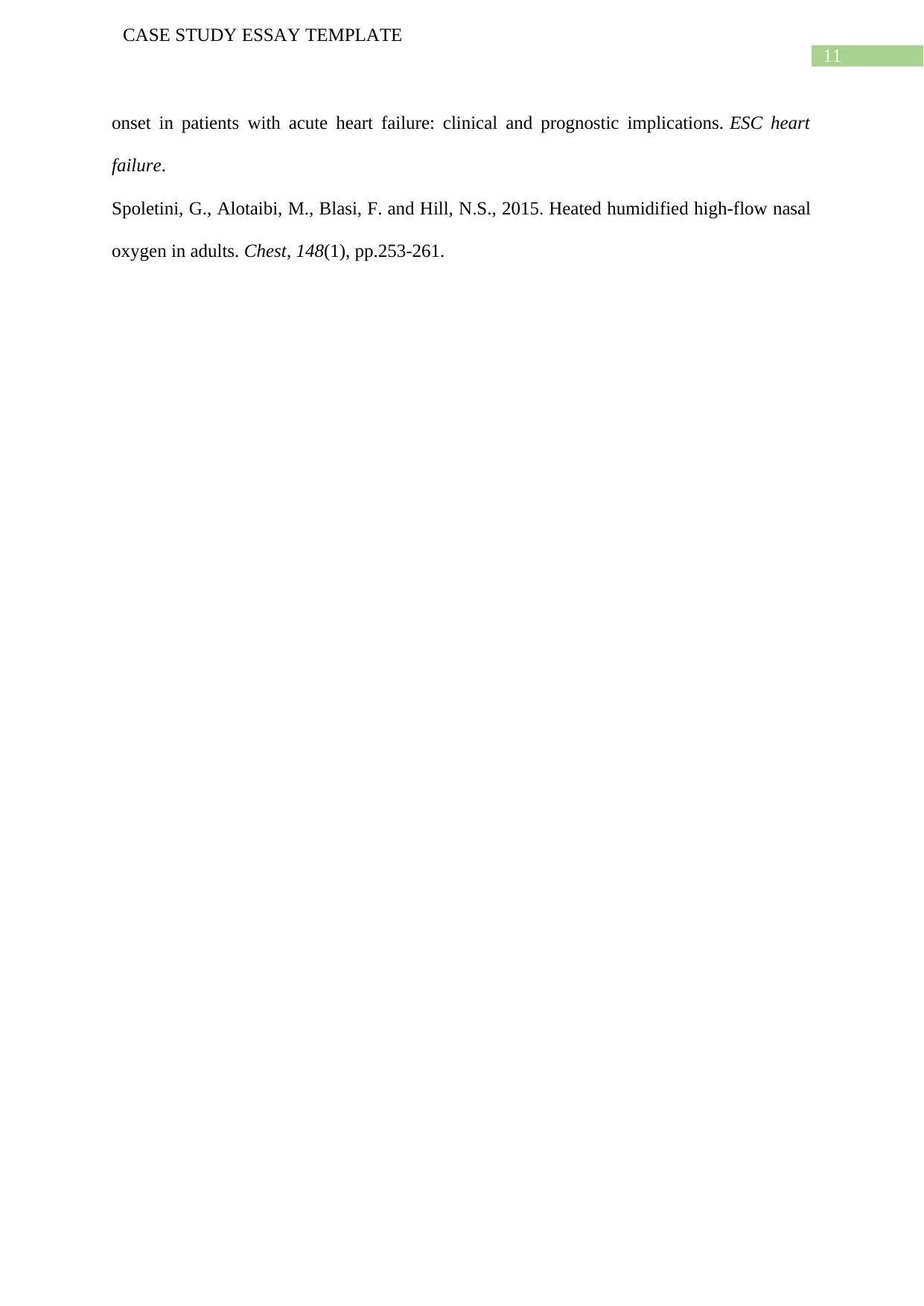
11
CASE STUDY ESSAY TEMPLATE
onset in patients with acute heart failure: clinical and prognostic implications. ESC heart
failure.
Spoletini, G., Alotaibi, M., Blasi, F. and Hill, N.S., 2015. Heated humidified high-flow nasal
oxygen in adults. Chest, 148(1), pp.253-261.
CASE STUDY ESSAY TEMPLATE
onset in patients with acute heart failure: clinical and prognostic implications. ESC heart
failure.
Spoletini, G., Alotaibi, M., Blasi, F. and Hill, N.S., 2015. Heated humidified high-flow nasal
oxygen in adults. Chest, 148(1), pp.253-261.
1 out of 11
Related Documents
Your All-in-One AI-Powered Toolkit for Academic Success.
+13062052269
info@desklib.com
Available 24*7 on WhatsApp / Email
![[object Object]](/_next/static/media/star-bottom.7253800d.svg)
Unlock your academic potential
© 2024 | Zucol Services PVT LTD | All rights reserved.





